200,000+ products from a single source!
sales@angenechem.com
Home > Cyclic Hypervalent Iodine Reagents: Enabling Tools for Bond Disconnection via Reactivity Umpolung
Cyclic Hypervalent Iodine Reagents: Enabling Tools for Bond Disconnection via Reactivity Umpolung
Durga Prasad Hari,† Paola Caramenti,† and Jerome Waser*
Laboratory of Catalysis and Organic Synthesis, Ecole Polytechnique Fedé rale de Lausanne, EPFL SB ISIC LCSO, BCH 4306, 1015 ́
Lausanne, Switzerland
1. INTRODUCTION AND CONTEXT
Organic compounds have a deep impact on our everyday life as drugs, agrochemicals, or materials. Over the last century, organic synthesis has matured as a craft and a science. Guidelines have been conceptualized to harness the fundamental properties of atoms, such as their electronegativity, to select adequate disconnections for bond formation.1 For example, functional groups containing electronegative atoms, such as nitrogen, halogens, oxygens, or sp2 and sp3 hybridized carbons, are best introduced as nucleophiles onto the carbon skeleton of organic compounds (Figure 1a). This approach is highly successful, but does not allow chemists to make all disconnections, as nucleophilic positions cannot be functionalized. To extend the versatility of organic synthesis, Seebach has introduced the concept of Umpolung (reversal of reactivity):2 If the innate reactivity of synthons can be inverted, new disconnections become possible, leading to greater diversity and synthetic
efficiency.
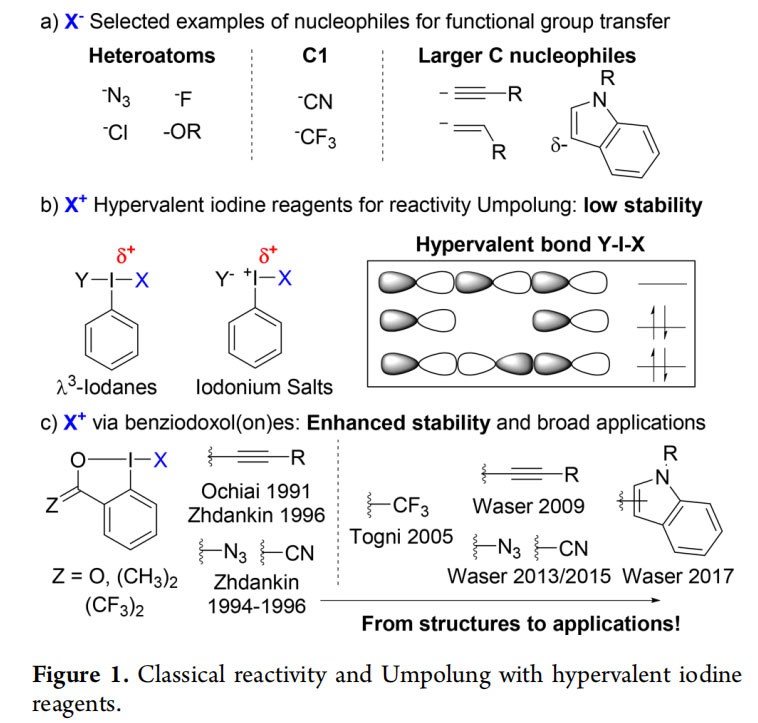
In this context, hypervalent iodine reagents have taken a privileged position based on the work of pioneers such as Beringer, Koser, Valvoglis, Moriarty, Zhdankin, Kita, Ochiai, and many others (Figure 1b).3 Both iodanes and iodonium salts allow the Umpolung of many nucleophiles into electrophilic synthons. Even if the concept of hypervalency is still a subject of controversy,4 it has been successfully used to rationalize the exceptional properties of hypervalent iodine reagents. However, their high reactivity can also lead to instability in the presence of strong bases, transition metals or when heating. In this context, benziodoxol(on)es (BX, Figure 1c), a class of cyclic hypervalent iodine reagents, have shown increased stability due to the inclusion of the iodine atom into a heterocycle.5,6 In particular, the groups of Ochiai and Zhdankin successively reported stable ethynyl (EBX),7,8 azido (ABX),9 and cyano (CBX)10 benziodoxol(on)es. A further advantage of BX reagents is the modulation of their reactivity through the trans-effect in the hypervalent bond.11 Derivatives bearing carboxy, isopropyl, and hexafluoroisopropyl substituents have been most broadly used.
For many years, structural studies on benziodoxolones have dominated the field, with few attempts in developing new synthetic applications. The situation changed in 2006, when Togni and co-workers reported the use of benziodoxol(on)es for trifluoromethylation.12 The so-called Togni reagents are now broadly used for the introduction of pharmaceutically relevant trifluoromethyl groups on organic compounds.13 Since 2008, our group has explored the potential of other BX reagents for group transfer reactions. We demonstrated that this class of reagents constitutes a unique toolbox for synthetic chemistry, which are superior to simple iodonium salts in many direct, transition metal- and photoredox- catalyzed transformations.
After having focused on electrophilic alkynylation,14 we moved to azidation and cyanation. In 2017, we introduced a new class of benziodoxolone reagents for the Umpolung of electron-rich heterocycles, in particular indoles and pyrroles. Many other groups have since then used BX compounds in group-transfer reactions.15,16 Herein, we will present an overview of our 10 year journey in the fascinating reactivity of these reagents
2. ELECTROPHILIC ALKYNYLATION
2.1. Alkynylation of Acidic C−H Bonds
We first encountered EBX reagents in 2010, when using alkynyliodonium salts for the alkynylation of enolates using reported methods.17,18 We were facing serious issues of reproducibility and were not able to induce enantioselectivity under phase-transfer conditions. Building on the higher stability of EBX reagents,7,8 we successfully used TMS-EBX (1a) and TBAF with stabilized enolates to give terminal alkynes 2a−f in excellent yields (Scheme 1).19 Asymmetric induction was now possible using Maruoka’s phase transfer catalyst (4) (Scheme2).
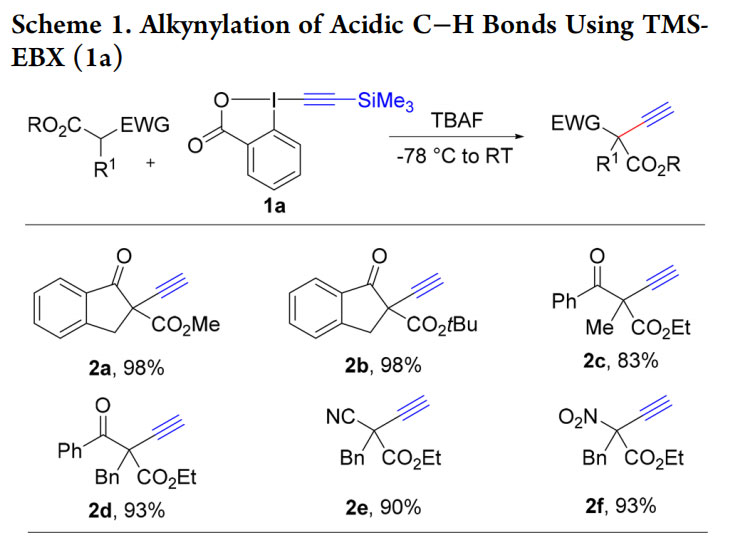
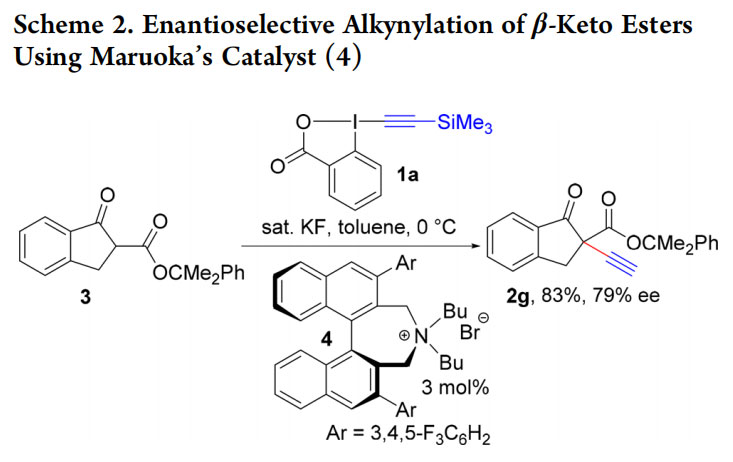
Two mechanisms can be envisaged (Scheme 3): Addition−elimination on the iodine atom (a) or conjugate addition to the alkyne, followed by reductive elimination and 1,2 shift (b). The use of 13C-labeled reagent 1b led to product 9, 19 which is in agreement with the 1,2 shift pathway.17,18
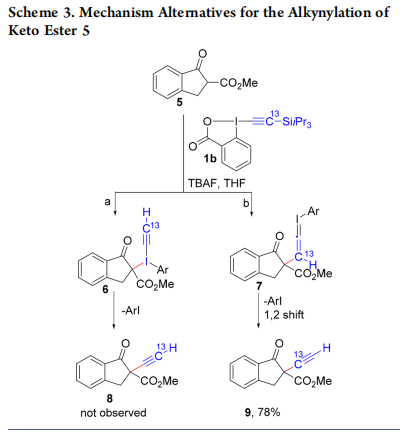
In 2014, as the phase-transfer approach was limited in both scope and enantioselectivity, we reported an alternative strategy to access quaternary stereocenters: Racemic alkynylation, followed by an enantioselective Tsuji−Trost allylation (Scheme 4).
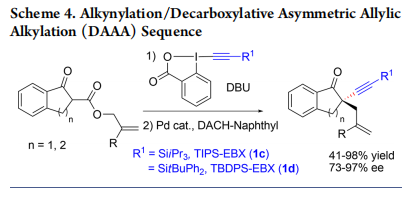
2.2. Alkynylation of Heteroatoms
In 2013, we wondered if EBX reagents could also contribute to a more efficient synthesis of thioalkynes. These compounds are usually synthesized by addition of acetylides to oxidized thiol precursors.22 Whereas only disulfides were obtained when the alkynylation was attempted with alkynyliodonium salts, a quantitative yield was realized using TIPS-EBX (1c) (Scheme 5).23,24 The reaction proceeded in 5 min at room temperature in an open flask with a wide range of EBX reagents and thiol or selenol substrates (products 10a−m).
A mechanism for the thiol-alkynylation reaction was proposed based on computational studies (Scheme 6).24 First, thiolate I could attack on the iodine atom of EBX to give II, which then undergoes reductive elimination to give the product. However, intermediate II was not observed in the computational studies.
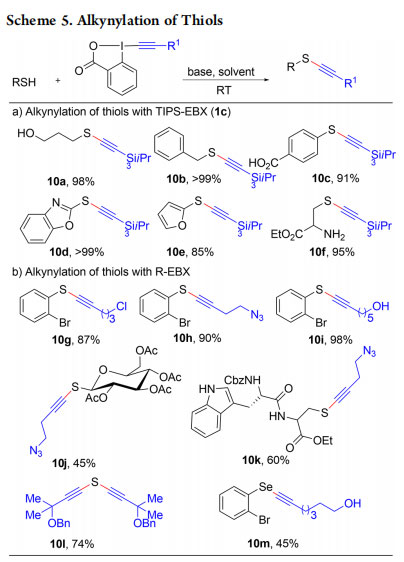
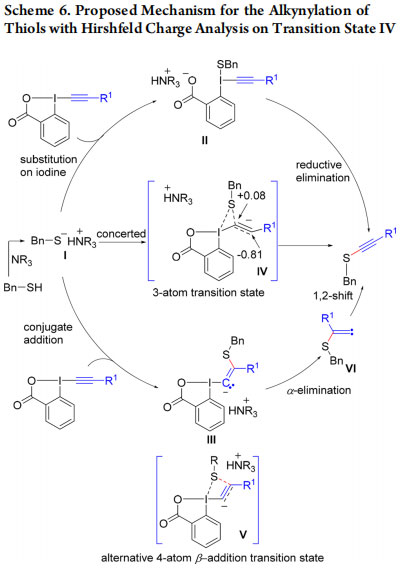
As an alternative, conjugate addition of thiolate I to give vinyl benziodoxolone III, which undergoes α-addition followed by 1,2 shift, leads to the product. This pathway was observed with a transition state energy of 23 kcal/mol. Nevertheless, a concerted pathway via asynchronous transition state IV with significant Hirshfeld charge separation was identified with a lower energy of 10.8 kcal/mol. In 2015, we further identified a four-atom transition state V leading to β-addition, which is favorable for alkyl groups on EBX, whereas α-addition is favored for electron withdrawing groups.25
The very fast and selective reaction of EBX reagents with thiols under mild conditions motivated us to investigate applications in chemical biology. In 2015, Adibekian and our group reported a method for proteomic profiling of enzymes with hyperactive cysteines in living cells by using the azidesubstituted EBX JW-RF-010 (1e) (Scheme 7).26 The utility of the method was further demonstrated by identifying one target of curcumin in HeLa cells.
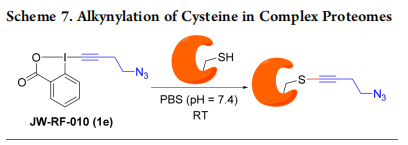
As a last effort in the area of heteroatom functionalization, we further demonstrated the use of EBX reagents for the alkynylation of other sulfur and phosphorus nucleophiles. Sulfones 11a−e were obtained from Grignard reagents or aryl iodides using DABSO (diazabicycloctane bis(sulfur dioxide)) as sulfur source (Scheme 8) 27 and alkynyl phosphorus derivatives 12a−e were synthesized from H-phosphi(na)tes and secondary phosphine oxides (Scheme 9).28
2.3. C−H Alkynylation of Hetero(arenes)
Our research on EBX reagents with simple nucleophiles had been highly successful, and we wondered if they could be also applied in the more complex settings of transition metal catalysis. Since 2007, using alkynyliodonium salts, C−H functionalization had been a major project in our group, but without success, as the sensitive reagents constantly decomposed in the presence of the metal catalyst. In 2009, we had our first success with the direct alkynylation of indoles using TIPSEBX (1c) and AuCl as catalyst (Scheme 10a).29 C3 alkynylated indoles 13a−c were obtained in good yields. The formation of C2-alkynylated indoles was observed when the C3 position was blocked (Scheme 10b, products 13d,e).30,31 The direct C−H alkynylation reaction was further extended to pyrroles (Scheme 10c, products 14a−c),32 thiophenes (Scheme 10d, products 15a−c),33 furans (Scheme 10e, products 16a−c),34 benzofurans (Scheme 10f, products 17a−c),35 and anilines and trimethoxy arenes (Scheme 11, products 18a−d).36
Initially, we hypothesized two mechanisms involving either an oxidative mechanism or a π-activation for the C−H alkynylation (Scheme 12).32 Oxidative addition of EBX on Au(I) would give Au(III) intermediate I. Electrophilic auration leads then to II and reductive elimination gives 13f. The π-activation involves coordination of Au(I) to the triple bond to give III, followed by nucleophilic attack leading to IV. Finally, α-elimination followed by 1,2-shift gives 13f. No silicon-shift was observed when C13 labeled reagent 1b was used. This result supports the oxidative mechanism. However, Ariafard found by computations that both the oxidative and π-activation mechanisms were too high in energy and proposed a iodine to gold shift on the alkyne to give intermediate V. 37 Indole addition to V, followed by β- elimination and rearomatization would lead to 13f. Common to the three mechanisms is an electrophilic aromatic substitution step, which explains the high regioselectivity observed. In 2013, we also reported a palladium-catalyzed selective C2 alkynylation.38 Other research groups later demonstrated that EBX reagents can be used for C−H alkynylation using a broad range of transition metal catalysts.16
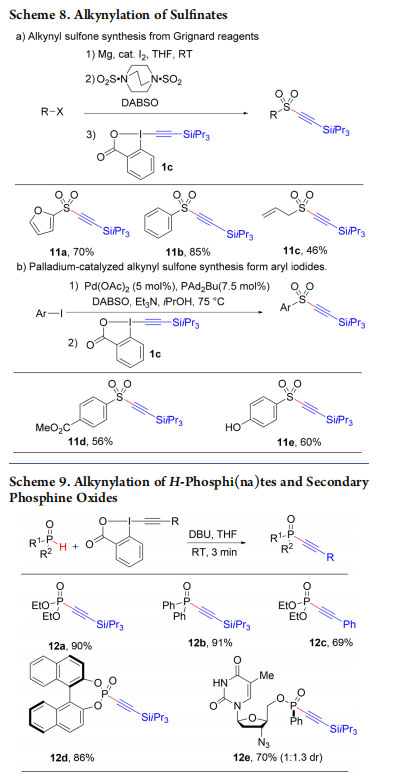
2.4. Alkynylation Involving Domino Reactions
In our work on heterocycles, we had demonstrated that EBX reagents could be used for a single sp2−sp bond formation. We then investigated their use in domino reactions leading to the alkynylation of sp3 centers. We reported the first example of such a transformation with the palladium-catalyzed intramolecular oxy- and amino-alkynylation of olefins using phenols, carboxylic acids, and imides as nucleophiles (Scheme 13, products 21, 22).39,40
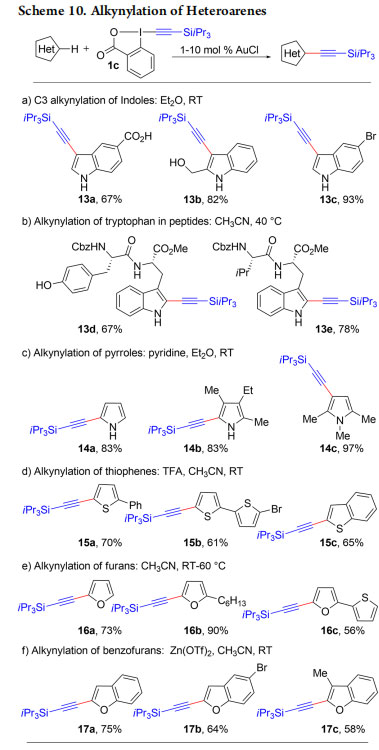
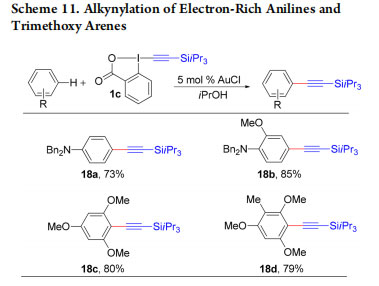
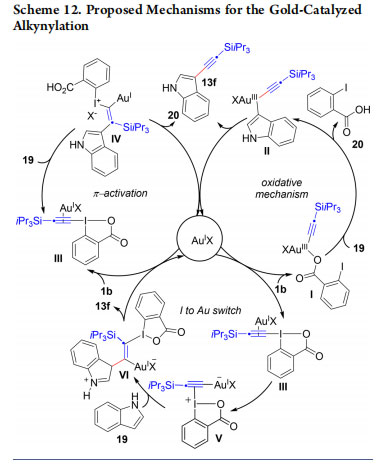
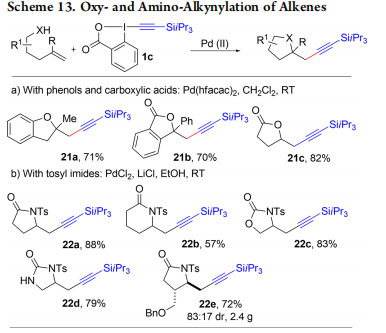
Initially, we proposed a mechanism involving a Pd(IV) intermediate II (Scheme 14).39 Oxy/aminopalladation of the olefin gives intermediate I, which undergoes oxidative addition with TIPS-EBX (1c) to give II, followed by reductive elimination. Ariafard proposed a different mechanism involving formation of palladium allenylidene intermediate III (in equilibrium with the iodine bound alkynyl palladium complex IV) based on computational studies.41 1,2-Shift followed by β- elimination of 2-iodobenzoic acid leads to the product. We then wondered then if domino processes could be also used for the synthesis of alkynylated heterocycles not accessible via C−H functionalization. As a proof of concept, we realized a one-pot synthesis of C3-alkynylated indoles 23a−c upon reaction of anilines with TIPS-EBX (1c) using a gold catalyst (Scheme 15).42
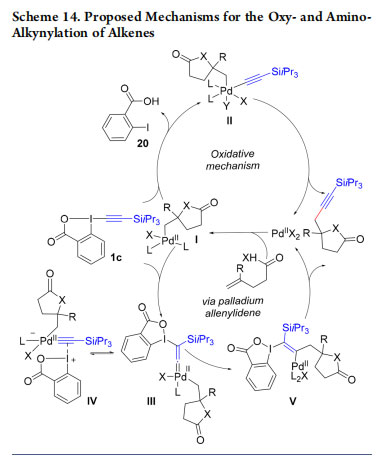
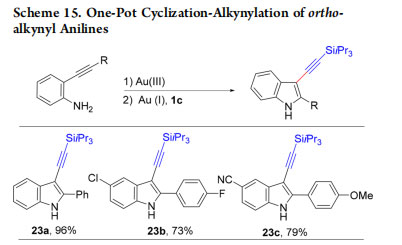
Nevertheless, such compounds can also be accessed via C−H functionalization. Therefore, we studied, in 2013, the dominocyclization-alkynylation of keto allenes into alkynyl furans using Au(III) picolinate as catalyst (Scheme 16).34 C3 alkynylated furans 24a−c were obtained in 68−97% yield, whereas C2 alkynylated furans are formed via C−H functionalization. In 2017, the reaction mechanism was studied by computational chemistry in collaboration with the Ariafard group (Scheme 17).43 Allene 25 first reacts with 1g and Au(III) to give iodonium I and Au(I) complex II. The latter then reacts with allene 25 to give III. Cyclization to IV followed by deprotonation with Na2CO3 gives V. Oxidative addition on V leading to VII and VIII is accelerated by the interaction of Au with the nitrogen atom (transition state VI). Au(III) complex VIII undergoes reductive elimination followed by ligand exchange with allene 25 to give product 24d and close the catalytic cycle. These interesting results showed that the Au(III) complex was only a precursor of the active Au(I) catalyst.
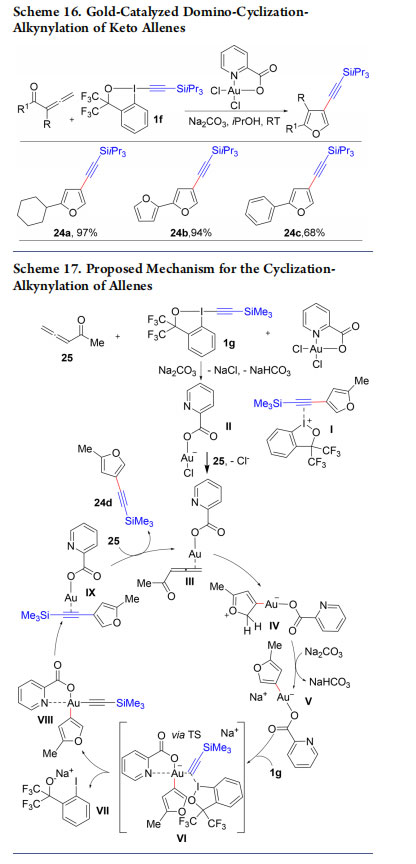
In 2015, we demonstrated that this strategy could also be used for the synthesis of indoles and carbazoles 26−29 alkynylated on the benzene ring (Scheme 18).44 This platinum-catalyzed process started from from 2- or 3-substituted homopropargylic pyrroles. The reaction probably proceeds via activation of the triple bond by platinum to give I (Scheme 19). Intramolecular attack of the most nucleophilic pyrrole C2 position gives then II. 1,2-Shift of the vinyl-platinum substituent via platinum carbene III then leads to IV. Finally, elimination of methanol and rearomatization gives platinum aryl complex V, which then reacts with 1f to deliver the product. In 2017, this mechanism was confirmed by Bi and co-workers based on computation.45
Highly conjugated hetereocycles are especially interesting as organic materials. In 2017, we used our strategy for the synthesis of C3-alkynylated benzofurans 30a−d and benzothiophenes 31a,b (Scheme 20).46 The obtained alkynylated heterocycles were efficiently transformed into heterotetracene building blocks for organic materials.
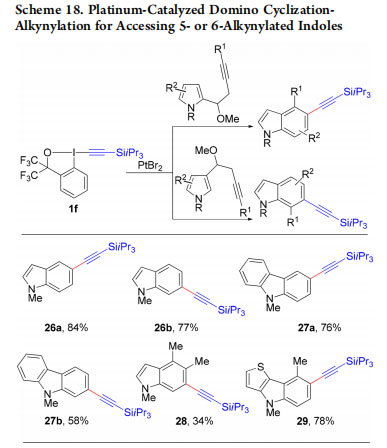
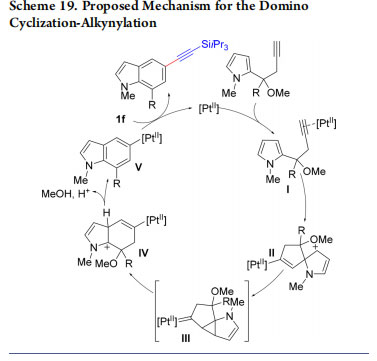
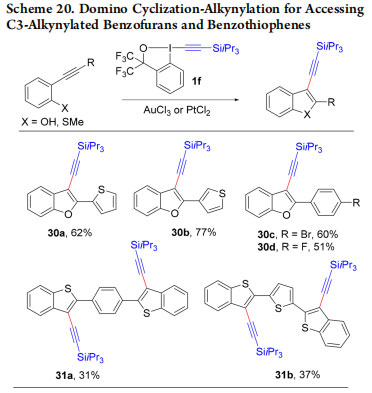
Alkynylation using EBXs usually releases 2-iodobenzoic acid. In 2016, we developed a copper-catalyzed oxyalkynylation of diazo compounds, in which the acid is incorporated in products 32a−f (Scheme 21a).47 When vinyl diazo compounds were used, enynes 33a−c were obtained as single geometric isomers(Scheme 21b). This example also demonstrates that the use of EBX reagent is not limited to precious metal catalysts, such as gold, platinum, or palladium.
In 2017, we reported the enantioselective oxyalkynylation of diazo compounds using a copper catalyst and bisoxazoline (BOX) ligand 34 (Scheme 22, products 35a−i).48 Due to the high acidity of the propargylic hydrogen, these compounds cannot be accessed in enantiopure form via the addition of organometallic reagents onto the corresponding carbonyl compounds.
2.5. Alkynylation of Carbon Radicals
EBX reagents are highly useful for the functionalization of carbon and heteroatom nucleophiles, as well as organometallic intermediates. The functionalization of radicals, which can be generated under neutral conditions, constitutes a further interesting area of applications. Li and co-workers were the first to report a decarboxylative alkynylation of carboxylic acids using EBX reagents and strong oxidants.49 In 2015, we developed milder conditions for the synthesis of alkynes 36a−f based on photoredox catalysis to avoid strong oxidants(Scheme 23).50 Xiao and co-workers reported a similar transformation simultaneously.51
A mechanism for the decarboxylative alkynylation was proposed based on both experimental and computational studies (Scheme 24).52 Single-electron oxidation of the carboxylate by the excited state of the Ir(III)-catalyst generates radical I after extrusion of CO2. Addition to EBX then delivers the desired product and iodo radical II, which can then be reduced by Ir(II) to close the catalytic cycle. Concerning the radical addition step, two mechanisms very close in energy were proposed based on DFT calculations: a concerted α-addition via III or a β-addition via IV.
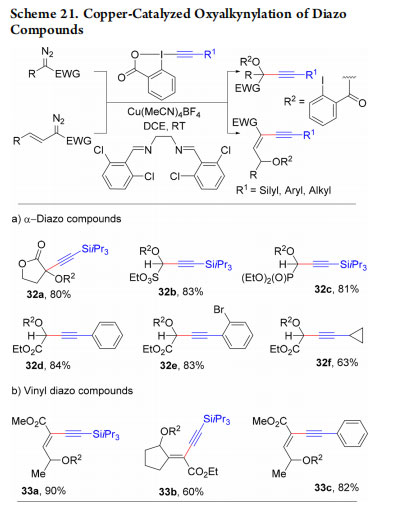
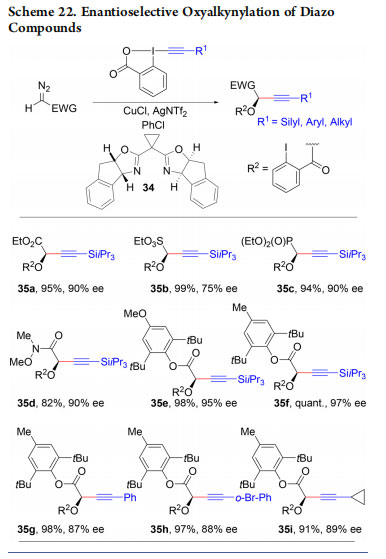
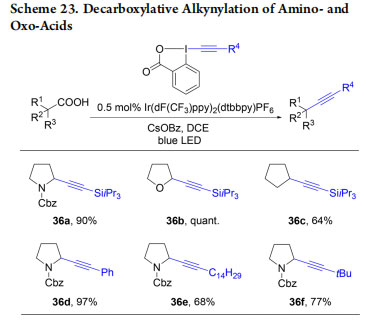
In 2018, we reported the alkynylation of nitrile-substituted alkyl radicals generated via oxidative ring fragmentation of cyclic oxime ethers (Scheme 25).53 The use of organic dye 38c with an increased reduction potential in the excited state compared to 4CzIPN (38a) led to the efficient fragmentation of both 4- and 5-membered cyclic oxime ethers to give the corresponding alkynylnitriles (39a−f). The reaction probably starts with the oxidation of the carboxylate by the excited photocatalyst. Fast decarboxylation followed by acetone extrusion leads to an imine radical. Fragmentation to an alkyl radical followed by alkynylation then gives the product.
3. ELECTROPHILIC AZIDATION
Azides, as alkynes, are versatile functional groups, which are usually introduced as nucleophiles. Electrophilic azide sources allow other disconnections. Noncyclic azide hypervalent iodine reagents are not stable and need to be prepared in situ. An important progress was realized when stable cyclic ABXs were introduced by Zhdankin and co-workers.9 Nevertheless, new synthetic applications emerged only in 2013, with the independent reports of Gade and co-workers,54 our group,55 and Studer and co-workers.56 Since then, the field is in full expansion.16
3.1. Azidation of β-Keto Esters and Silyl Enol Ethers
In 2013, we investigated the azidation of ketoester-derived enolates with ABXs as a proof-of-concept transformation. Such azidation had been realized with other hypervalent iodine reagents,57 but had not been reported with ABXs when we started our investigations. A metal free protocol for cyclic indanones was developed using azidobenziodoxole 40 (41a−c, Scheme 26).55 However, less reactive substrates such as silyl enol ethers and noncyclic keto esters did not react with 40. In this case, activation of the reagent with zinc triflate as catalyst was necessary to give products 42a−d. In parallel to our work,
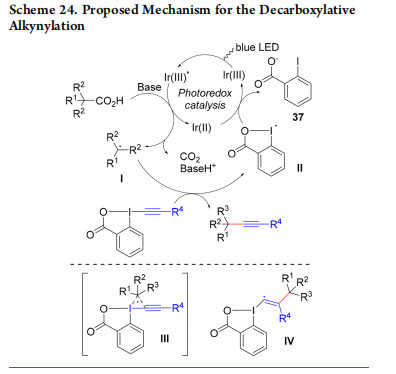
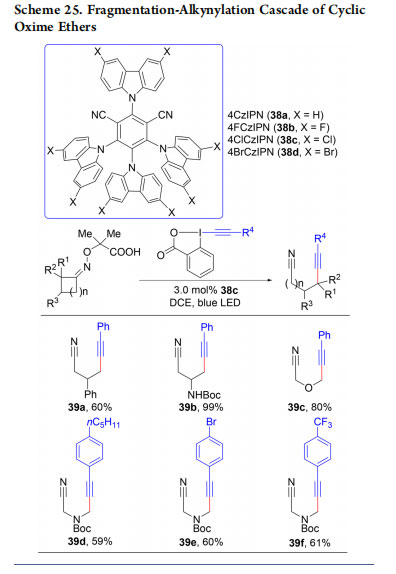
Gade and co-workers reported an efficient enantioselective azidation of ketoesters using reagent 40. We then reinvestigated the Tsuji−Trost approach on allyl β-keto esters (Scheme 27). Homoallylic azides 43a−c were obtained in good yields and excellent enantioselectivities.58
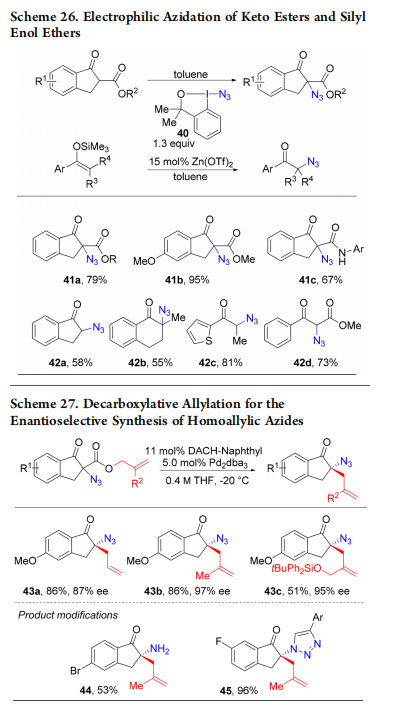
Staudinger reduction and 1,3 cycloaddition gave then homoallylic amine 44 and triazole 45.
3.2. Generation of Azido Radicals: Azido-Lactonization and Ring Expansion
In 2017, our group became interested in using azidobenziodoxol(on)es reagents for the azido-lactonization of styrene derivatives in the context of extending the olefin functionalization reactions developed with oxyalkynylation (Scheme 28).59 Photoredox activation of ABX 46 (Zhdankin reagent)9 resulted in formation of an azido radical,56,60 which reacted with the styrenes to form 1,2-azidolactones 47a−d. No radical was formed from the weaker oxidizing 40. In this case, the use of Pd(hfacac)2 as Lewis acid gave 1,1-azidolactones 48a−d, probably via a iodination, 1,2-aryl shift, azidation sequence, highlighting again the possibility to finely tune the reactivity of EBX reagents.
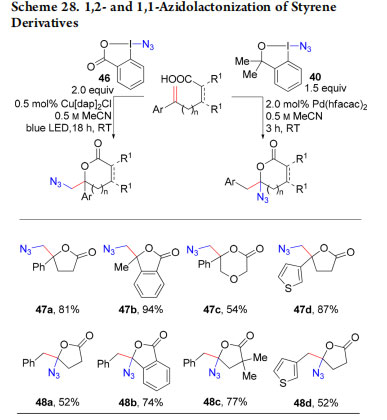
Following an accident due to the explosion of a sample of ABX 46, we investigated its safety profile in collaboration with a specialized company, and discovered that it is both shock and friction sensitive.61 However, the more stable azidobenziodazole 49 (ABZ) could also be used for the generation of radicals under photoredox conditions in a new ring-expansion process to give cyclopentanones 50a−d (Scheme 29), as well as in reported azidative transformations.61
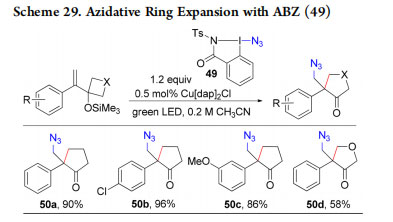
4. ELECTROPHILIC CYANATION
4.1. Synthesis of Homoallylic Nitriles
As for alkynes or azides, we expected CBXs10 to serve as electrophilic cyanide sources. In fact, CBX (51) could be used for the cyanation of allylic β keto esters, which were engaged in an enantioselective Tsuji−Trost process (Scheme 30, products 52a−c).58 The nitrile group could be then either reduced to amine 53 or hydrated to amide 54.
4.2. Synthesis of Thiocyanates from Thiols
Inspired by our results in thio-alkynylation (Scheme 5), we reported the use of CBX (51) for the cyanation of thiols (Scheme 31).62 Aromatic and aliphatic thio- and selenocyanates 55−58 were obtained in excellent yields. Interestingly, hypervalent sulfur reagents were later developed by Alcarazo and coworkers to perform similar reactions.63
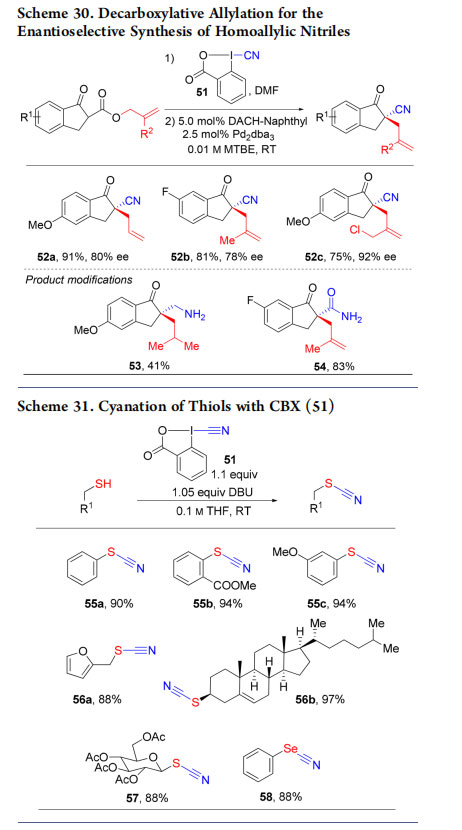
4.3. Decarboxylative Cyanation of Carboxylic Acids
Our work in the photoredox-catalyzed decarboxylative alkynylation was extended to decarboxylative cyanation using CBX (51) to give nitriles 59 and 60 (Scheme 32).52 In contrast to alkynylation, cyanation was shown through experiments and DFT calculations to proceed via carbocationic intermediates (Scheme 33). CBX (51) being a stronger oxidant than EBX (1), it is able to oxidize radical I, formed under
photoredox conditions, to give stabilized carbocation II and radical anion III (single electron transfer, SET). The latter collapses into radicalIV and cyanide anion (61). Recombination of II and 61 gives the product, whereas IV can re-enter the photoredox cycle (Scheme 24).
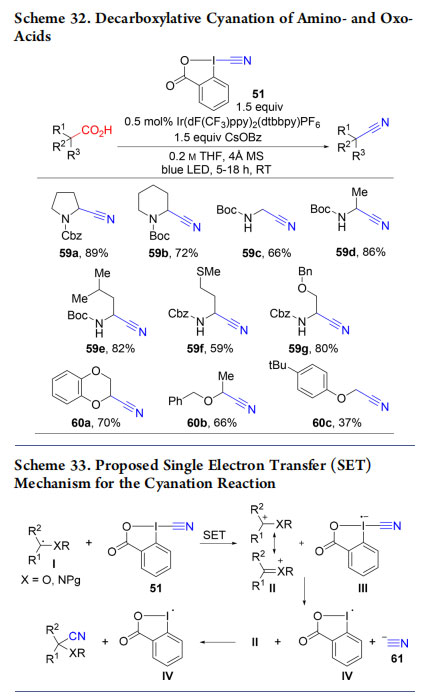
5. ELECTROPHILIC INDOLES AND PYRROLES
5.1. Synthesis of New Indole and Pyrrole BX Reagents
In 2017, we reported the serendipitous discovery of a novel class of stable cyclic indole- and pyrrole-based BX reagents.64−66 C3-substituted-indole and pyrrole BX reagents 62−64 were accessed from the heterocycles by the Lewis acid catalyzed addition to acetoxybenziodoxol(on)es (Scheme 34a).64,65 C2-substituted indole BX reagents 65a−c were obtained by reaction of trifluoroborate salts with fluorobenziodoxole (Scheme 34b).66
5.2. Metal-Catalyzed C−H Functionalization with IndoleBXs and PyrroleBXs
In most metal-catalyzed C−H arylation processes, electron-rich heterocycles are used as nucleophilic partners, leading often to regioselectivity and reactivity issues. Our electrophilic reagents allowed an Umpolung approach in the Rh(III)- and Ru(II)- catalyzed directed C−H functionalization of arenes (Scheme 35a,b). The desired heteroarylated products were obtained in good yields as single regioisomers using either pyridine (66a−c) or methoxamide (67a−c) directing groups.64,65 Heteroarylated 2- and 4-pyridones 68 and 69 and quinoline N-oxide 70 could also be accessed (Scheme 35c).67 Finally, the method could be extended to ortho-hydroxy and amido benzaldehydes using either a Rh(III) or an Ir(III) catalyst (Scheme 35d, products 71−73).68 None of these transformations was successful using the corresponding aryl iodides or iodonium salts.
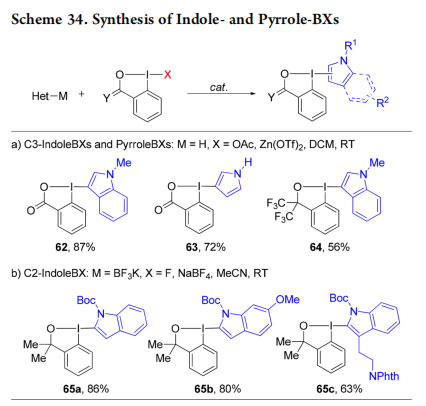
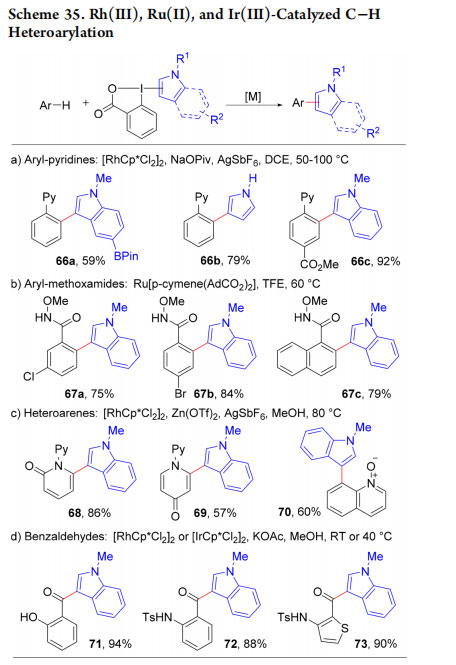
5.3. Metal-Free Oxidative Cross-Coupling for the Synthesis of Mixed Biheterocycles
In 2018, we reported a metal-free oxidative cross coupling using TMSCl and HFIP as activators for the synthesis of mixed biindoles 74a−c and other mixed heteroaryls 75−77 (Scheme 36).66 This method allowed the synthesis of biheterocycles with complete regioselective installation of functional groups in either one of the two reacting partners. The reasons for the exclusive transfer of the indole heterocycle and the observed high regioselectivity are not well understood at this stage and will require further mechanistic studies.
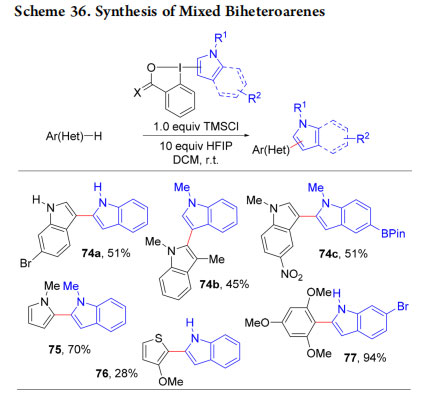
6. CONCLUSION
Since 2008, our group has exploited the reactivity of benziodoxol(on)es reagents in organic synthesis. The basis for this work had been set by synthetic and structural studies by pioneers in the field of hypervalent iodine chemistry, such as Martin, Ochiai, and Zhdankin among others. The potential of these reagents for fine chemical synthesis via “Umpolung disconnections” was first demonstrated extensively by Togni and co-workers in trifluoromethylation and our group in alkynylation. Our work on ethynylbenziodoxolone (EBX) reagents showed for the first time their exceptional properties in the electrophilic alkynylation of nucleophiles, radicals, and organometallic intermediates. We then demonstrated that azidobenziodoxolones (ABX) and cyanobenziodoxolones (CBX) were equally useful for electrophilic azidation and cyanation. Finally, we introduced new reagents for the Umpolung of indoles and pyrroles. Nowadays, many research groups around the world are using cyclic hypervalent iodine reagents to develop new transformations. The reason for the success of BX reagents may reside in the exceptional reactivity of hypervalent iodine, combined with the extra stability and modularity of the cyclic structure. We expect that the “synthetic treasure” of benziodoxol(on)es has just started to be exploited, and many more reagents and transformations still remain to be discovered。
■ AUTHOR INFORMATION
Corresponding Author
*E-mail: jerome.waser@epfl.ch.
ORCID
Jerome Waser: 0000-0002-4570-914X
Author Contributions
†
D.P.H. and P.C. contributed equally.
Notes
The authors declare no competing financial interest.
Biographies
Durga Prasad Hari received his master degree from IIT Madras and his PhD degree from the University of Regensburg under the supervision of Prof. Dr. Burkhard Koenig in 2014. He worked as postdoctoral fellow under the supervision of Prof. Jerome Waser at EPFL from 2014 to 2018. Currently, he is a postdoctoral fellow in the group of Prof. Varinder Aggarwal at the University of Bristol. His research interests
focus on applications of hypervalent iodine reagents in organic synthesis. He was a finalist of Reaxys PhD prize 2012.
Paola Caramenti received her Master degree in 2014 at Università Statale di Milano, under the guidance of Prof. Francesca Clerici. She then joined the group of Prof. Jerome Waser at EPFL to pursue her PhD
studies. Her current research topic involves the synthesis of novel hypervalent iodine reagents and their application. Jerome Waser studied chemistry at ETH Zurich (PhD degree in 2006 with Prof. Erick M. Carreira). He then joined Prof. Barry M. Trost at Stanford University as SNF postdoctoral fellow. From 2007 to 2014, he was an assistant professor at EPFL. Since 2014, he is associate professor at EPFL, focusing on the use of hypervalent iodine reagents in synthesis, cyclopropane chemistry and tethered reactions. He received the ERC starting (2013) and consolidator (2017) grants, the Werner prize of the Swiss Chemical Society 2014, and the Springer Heterocyclic Chemistry Award 2016.
■ ACKNOWLEDGMENTS
We thank the Swiss National Science Foundation (No. 200021_159920), the European Research Council (ERC Starting Grant 334840), and EPFL for financial support.
Organic compounds have a deep impact on our everyday life as drugs, agrochemicals, or materials:
CAS No. 100-54-9Catalog No.:AG00007C MDL No.:MFCD00006372 MF:C6H4N2 MW:104.1094 |
CAS No. 100-55-0Catalog No.:AG00007B MDL No.:MFCD00006407 MF:C6H7NO MW:109.1259 |
CAS No. 100-60-7Catalog No.:AG000076 MDL No.:MFCD00003832 MF:C7H15N MW:113.2007 |
CAS No. 100-62-9Catalog No.:AG000074 MDL No.: MF:C7H7N MW:105.1372 |
CAS No. 100-64-1Catalog No.:AG000072 MDL No.:MFCD00001660 MF:C6H11NO MW:113.1576 |
CAS No. 100-65-2Catalog No.:AG000071 MDL No.:MFCD00045718 MF:C6H7NO MW:109.1259 |
CAS No. 100-67-4Catalog No.:AG00006Z MDL No.:MFCD00036027 MF:C6H6KO MW:133.2095 |
CAS No. 100-68-5Catalog No.:AG00006Y MDL No.:MFCD00008559 MF:C7H8S MW:124.2034 |
CAS No. 100-70-9Catalog No.:AG00006W MDL No.:MFCD00006218 MF:C6H4N2 MW:104.1094 |
CAS No. 100-77-6Benzenediazonium, 3-chloro-, chloride (1:1) Catalog No.:AG000080 MDL No.: MF:C6H4Cl2N2 MW:175.0154 |
CAS No. 100-80-1Catalog No.:AG00007Z MDL No.:MFCD00008617 MF:C9H10 MW:118.1757 |
CAS No. 100-81-2Catalog No.:AG00007Y MDL No.:MFCD00008118 MF:C8H11N MW:121.1796 |
CAS No. 100-82-3Catalog No.:AG00007X MDL No.:MFCD00008113 MF:C7H8FN MW:125.1435 |
CAS No. 100-83-4Catalog No.:AG00007W MDL No.:MFCD00003368 MF:C7H6O2 MW:122.1213 |
CAS No. 100-84-5Catalog No.:AG00007V MDL No.:MFCD00008395 MF:C8H10O MW:122.1644 |
CAS No. 100-85-6Benzenemethanaminium, N,N,N-trimethyl-, hydroxide (1:1) Catalog No.:AG00007U MDL No.:MFCD00008281 MF:C10H17NO MW:167.2481 |
CAS No. 100-87-8Catalog No.:AG00007T MDL No.: MF:C7H8O3S MW:172.2016 |
CAS No. 100-88-9Catalog No.:AG00007S MDL No.:MFCD00065234 MF:C6H13NO3S MW:179.2373 |
CAS No. 100-90-3Acetamide, N-[4-[[(4,6-dimethyl-2-pyrimidinyl)amino]sulfonyl]phenyl]- Catalog No.:AG00007R MDL No.:MFCD00185750 MF:C14H16N4O3S MW:320.3668 |
CAS No. 100-94-7Benzenemethanaminium, N,N-dimethyl-N-(phenylmethyl)-, chloride (1:1) Catalog No.:AG00007Q MDL No.:MFCD00031706 MF:C16H20ClN MW:261.7897 |
CAS No. 100-96-91,3-Benzenediamine, 5-methoxy- Catalog No.:AG00007P MDL No.: MF:C7H10N2O MW:138.1671 |
CAS No. 1000-00-6Disiloxane, 1,1,3,3-tetraethyl-1,3-dimethyl- Catalog No.:AG00007N MDL No.:MFCD00067553 MF:C10H26OSi2 MW:218.4838 |
CAS No. 1000-05-1Tetrasiloxane, 1,1,3,3,5,5,7,7-octamethyl- Catalog No.:AG00007M MDL No.:MFCD00039789 MF:C8H26O3Si4 MW:282.6322 |
CAS No. 1000-16-4Phosphonic acid, P-[(dibutylamino)methyl]-, diethyl ester Catalog No.:AG00007L MDL No.: MF:C13H30NO3P MW:279.3560 |
CAS No. 1000-23-3Acetic acid, 1,1'-(dichlorostannylene) ester Catalog No.:AG00007K MDL No.: MF:C4H6Cl2O4Sn MW:307.6950 |
CAS No. 1000-30-2Catalog No.:AG00007I MDL No.:MFCD17014642 MF:C9H16O MW:140.2227 |
CAS No. 1000-40-4Stannane, bis(butylthio)dimethyl- Catalog No.:AG00007H MDL No.: MF:C10H24S2Sn MW:327.1286 |
CAS No. 1000-41-5Catalog No.:AG00007G MDL No.: MF:C10H18O MW:154.2493 |
CAS No. 1000-43-7Catalog No.:AG00007F MDL No.: MF:C8H18Cl2Si MW:213.2200 |
CAS No. 1000-44-81,3-Hexadiyne, 5-chloro-5-methyl- Catalog No.:AG00008P MDL No.: MF:C7H7Cl MW:126.5835 |
CAS No. 1000-49-3Catalog No.:AG00008N MDL No.: MF:C7H18Si MW:130.3033 |
CAS No. 1000-50-6Catalog No.:AG00008M MDL No.:MFCD00015727 MF:C6H15ClSi MW:150.7218 |
CAS No. 1000-56-2Sulfuric acid, monopropyl ester, sodium salt (1:1) Catalog No.:AG00008L MDL No.: MF:C3H7NaO4S MW:162.1400 |
CAS No. 1000-57-3Stannane, trimethyl(propylthio)- Catalog No.:AG00008K MDL No.: MF:C6H16SSn MW:238.9572 |
CAS No. 1000-58-4Silane, trichloro(3-chlorobutyl)- Catalog No.:AG00008J MDL No.: MF:C4H8Cl4Si MW:226.0038 |
CAS No. 1000-62-0Silane, (2-ethoxyethynyl)trimethyl- Catalog No.:AG00008I MDL No.: MF:C7H14OSi MW:142.2710 |
CAS No. 1000-63-1Butane, 1-(1,1-dimethylethoxy)- Catalog No.:AG00008H MDL No.: MF:C8H18O MW:130.2279 |
CAS No. 1000-67-5Sulfuric acid, monobutyl ester, sodium salt (1:1) Catalog No.:AG00008G MDL No.:MFCD00024891 MF:C4H9NaO4S MW:176.1666 |
CAS No. 1000-69-7Stannane, (butylthio)trimethyl- Catalog No.:AG00008F MDL No.: MF:C7H18SSn MW:252.9838 |
CAS No. 1000-78-81,6-Hexanediamine, N1,N6-bis(2,2-dimethylpropylidene)- Catalog No.:AG00008D MDL No.: MF:C16H32N2 MW:252.4387 |
CAS No. 1000-82-4Catalog No.:AG00008C MDL No.:MFCD00462847 MF:C2H6N2O2 MW:90.0812 |
CAS No. 1000-83-5Catalog No.:AG00008B MDL No.: MF:C2H6N2OS MW:106.1468 |
CAS No. 1000-84-6Catalog No.:AG00008A MDL No.:MFCD00297109 MF:C4H9NO MW:87.1204 |
CAS No. 1000-86-8Catalog No.:AG000089 MDL No.:MFCD00008903 MF:C7H12 MW:96.1702 |
CAS No. 1000-87-9Catalog No.:AG000088 MDL No.:MFCD00060915 MF:C7H12 MW:96.1702 |
CAS No. 1000-91-5Silane, dimethyl(1-methylethoxy)- Catalog No.:AG000087 MDL No.: MF:C5H14OSi MW:118.2496 |
CAS No. 10000-20-1Hydrazine, 1,2-bis[(1,1-dimethylethyl)dimethylsilyl]- Catalog No.:AG000086 MDL No.: MF:C12H32N2Si2 MW:260.5669 |
CAS No. 10000-51-82-Naphthalenecarboxamide, 3-hydroxy-N-(2-methoxyethyl)- Catalog No.:AG000085 MDL No.: MF:C14H15NO3 MW:245.2738 |
CAS No. 10000-56-32-Naphthalenecarboxamide, N-butyl-4-[2-(2,5-dimethoxyphenyl)diazenyl]-3-hydroxy- Catalog No.:AG000084 MDL No.: MF:C23H25N3O4 MW:407.4623 |
CAS No. 1000007-15-73-Quinolinecarboxylic acid, 2,4-dibromo-, ethyl ester Catalog No.:AG000083 MDL No.: MF:C12H9Br2NO2 MW:359.0134 |
CAS No. 1000010-11-6Catalog No.:AG000082 MDL No.: MF:C28H46Cl2N2O2 MW:513.5830 |
CAS No. 1000017-92-4Pyridine, 3,5-dibromo-2-chloro-4-methyl- Catalog No.:AG000081 MDL No.:MFCD09864796 MF:C6H4Br2ClN MW:285.3637 |
CAS No. 1000017-93-5Imidazo[1,2-a]pyridine-2-carboxylic acid, 5-chloro- Catalog No.:AG00009C MDL No.:MFCD09836168 MF:C8H5ClN2O2 MW:196.5905 |
CAS No. 1000017-97-9Imidazo[1,2-a]pyridine-2-carboxylic acid, 5-amino-, ethyl ester Catalog No.:AG00009B MDL No.:MFCD09842618 MF:C10H11N3O2 MW:205.2132 |
CAS No. 1000017-98-0Imidazo[1,2-a]pyridine-2-carboxylic acid, 8-bromo-6-chloro- Catalog No.:AG00009A MDL No.:MFCD09836172 MF:C8H4BrClN2O2 MW:275.4866 |
CAS No. 1000018-06-31H-Indazol-3-amine, 5-bromo-1-methyl- Catalog No.:AG000099 MDL No.:MFCD09864804 MF:C8H8BrN3 MW:226.0732 |
CAS No. 1000018-10-93-Pyridinamine, 2,6-dibromo-5-ethoxy- Catalog No.:AG000098 MDL No.:MFCD09864810 MF:C7H8Br2N2O MW:295.9592 |
CAS No. 1000018-13-2Benzoic acid, 2-amino-5-bromo-4-(1-methylethyl)-, methyl ester Catalog No.:AG000097 MDL No.:MFCD09864815 MF:C11H14BrNO2 MW:272.1384 |
CAS No. 1000018-21-21-Piperazinecarboxylic acid, 4-[[[(1,1-dimethylethoxy)carbonyl]amino]sulfonyl]-, phenylmethyl ester Catalog No.:AG000096 MDL No.:MFCD09864831 MF:C17H25N3O6S MW:399.4619 |
CAS No. 1000018-22-31-Piperazinecarboxylic acid, 4-[5-bromo-3-(methoxycarbonyl)-2-pyridinyl]-, 1,1-dimethylethyl ester Catalog No.:AG000095 MDL No.:MFCD09864832 MF:C16H22BrN3O4 MW:400.2676 |
CAS No. 1000018-23-44-Piperidinecarboxylic acid, 1-(1,6-dihydro-6-oxo-4-pyridazinyl)-, ethyl ester Catalog No.:AG000094 MDL No.:MFCD09864836 MF:C12H17N3O3 MW:251.2817 |
CAS No. 1000018-24-51(6H)-Pyridazineacetic acid, 6-oxo-4-(1-piperazinyl)-, ethyl ester Catalog No.:AG000093 MDL No.:MFCD09864837 MF:C12H18N4O3 MW:266.2963 |
CAS No. 1000018-25-64-Piperidinecarboxylic acid, 1-[[[(1,1-dimethylethoxy)carbonyl]amino]sulfonyl]-, ethyl ester Catalog No.:AG000092 MDL No.:MFCD09864838 MF:C13H24N2O6S MW:336.4045 |
CAS No. 1000018-26-7Carbamic acid, N-(2,2,4-trimethyl-3-oxo-1-phenylpentyl)-, methyl ester Catalog No.:AG000091 MDL No.:MFCD09864844 MF:C16H23NO3 MW:277.3587 |
CAS No. 1000018-48-3Benzoic acid, 4-(methylsulfonyl)-3-(1-pyrrolidinyl)- Catalog No.:AG000090 MDL No.:MFCD09743732 MF:C12H15NO4S MW:269.3168 |
CAS No. 1000018-56-3Imidazo[1,2-a]pyrazine-2-carboxylic acid, 6-bromo- Catalog No.:AG00008Z MDL No.:MFCD09414724 MF:C7H4BrN3O2 MW:242.0296 |
CAS No. 1000018-58-5Pyridine, 3,5-dibromo-2-chloro-6-methyl- Catalog No.:AG00008Y MDL No.:MFCD09702430 MF:C6H4Br2ClN MW:285.3637 |
CAS No. 1000018-59-6Thiophene, 2-bromo-5-(diethoxymethyl)-3-methyl- Catalog No.:AG00008X MDL No.:MFCD06657808 MF:C10H15BrO2S MW:279.1939 |
CAS No. 1000018-63-21,3,5-Triazine-2(1H)-thione, 6-phenyl- Catalog No.:AG00008W MDL No.:MFCD09702439 MF:C9H7N3S MW:189.2370 |
CAS No. 1000018-70-13-Piperidinecarboxylic acid, 1-(2-carboxy-4-nitrophenyl)-, 3-ethyl ester Catalog No.:AG00008V MDL No.:MFCD09064901 MF:C15H18N2O6 MW:322.3132 |
CAS No. 1000018-71-2Benzoic acid, 4-(4-methyl-1-piperazinyl)-3-nitro-, ethyl ester Catalog No.:AG00008U MDL No.:MFCD09064902 MF:C14H19N3O4 MW:293.3184 |
CAS No. 1000025-92-22-Pyridinecarbonitrile, 3,5-bis(phenylmethoxy)- Catalog No.:AG00008S MDL No.:MFCD19689665 MF:C20H16N2O2 MW:316.3532 |
CAS No. 1000025-93-32-Pyridinecarboxylic acid, 3,5-bis(phenylmethoxy)- Catalog No.:AG00008R MDL No.:MFCD19689666 MF:C20H17NO4 MW:335.3533 |
CAS No. 1000029-07-1Catalog No.:AG00008Q MDL No.: MF:C9H6INS MW:287.1201 |
CAS No. 100003-85-85H-Thiazolo[3,2-a]pyrimidin-5-one, 7-(chloromethyl)-3-(4-chlorophenyl)- Catalog No.:AG00009E MDL No.: MF:C13H8Cl2N2OS MW:311.1864 |
CAS No. 100004-92-04-Pyridinecarboxylic acid, 2-(2-naphthalenyl)- Catalog No.:AG0000A3 MDL No.: MF:C16H11NO2 MW:249.2640 |
CAS No. 100004-93-14-Pyridinecarboxylic acid, 2-(1-naphthalenyl)- Catalog No.:AG0000A2 MDL No.: MF:C16H11NO2 MW:249.2640 |
CAS No. 100004-94-24-Pyridinecarboxylic acid, 2-(3-methylphenyl)- Catalog No.:AG0000A1 MDL No.:MFCD14666477 MF:C13H11NO2 MW:213.2319 |
CAS No. 100004-95-34-Pyridinecarboxylic acid, 2-(3-methoxyphenyl)- Catalog No.:AG0000A0 MDL No.:MFCD14666479 MF:C13H11NO3 MW:229.2313 |
CAS No. 1000045-93-17-Quinolinecarboxylic acid, 1,2,3,4-tetrahydro-2-oxo-, methyl ester Catalog No.:AG00009M MDL No.:MFCD24387120 MF:C11H11NO3 MW:205.2099 |
CAS No. 100005-01-4Silane, [bromo[[(trimethylsilyl)methyl]thio]methyl]trimethyl- (9CI) Catalog No.:AG00009Z MDL No.: MF:C8H21BrSSi2 MW:285.3923 |
CAS No. 100005-12-73H-Cyclobut[b]indole, 4-chloro-2a,7b-dihydro-3-methyl- Catalog No.:AG00009Y MDL No.: MF:C11H10ClN MW:191.6568 |
CAS No. 100005-23-03-Thiophenecarbonitrile, 2-amino-4-(4-methoxyphenyl)-5-methyl- Catalog No.:AG00009X MDL No.:MFCD02609524 MF:C13H12N2OS MW:244.3122 |
CAS No. 100005-68-3Benzoic acid, 4-(2-furanyloxy)-, ethyl ester Catalog No.:AG00009W MDL No.: MF:C13H12O4 MW:232.2320 |
CAS No. 100005-79-6Benzonitrile, 4-(2-thienylmethyl)- Catalog No.:AG00009V MDL No.:MFCD11055265 MF:C12H9NS MW:199.2716 |
CAS No. 1000053-23-5Carbamic acid, N-[1-(4-amino-2-fluorophenyl)-4-piperidinyl]-, 1,1-dimethylethyl ester Catalog No.:AG00009L MDL No.:MFCD08443960 MF:C16H24FN3O2 MW:309.3791 |
CAS No. 1000053-44-01-Piperidinecarboxylic acid, 4-[(4-amino-2-fluorophenoxy)methyl]-, 1,1-dimethylethyl ester Catalog No.:AG00009K MDL No.: MF:C17H25FN2O3 MW:324.3904 |
CAS No. 1000058-38-71H-Indole-3-acetic acid, α-amino-1-methyl- Catalog No.:AG00009J MDL No.: MF:C11H12N2O2 MW:204.2252 |
CAS No. 1000068-23-4(1-(tert-Butoxycarbonyl)-4-methoxy-1H-indol-2-yl)boronic acid Catalog No.:AG00009I MDL No.:MFCD11616286 MF:C14H18BNO5 MW:291.1074 |
CAS No. 1000068-24-51H-Indole-1-carboxylic acid, 2-borono-7-chloro-, 1-(1,1-dimethylethyl) ester Catalog No.:AG00009H MDL No.:MFCD11616285 MF:C13H15BClNO4 MW:295.5265 |
CAS No. 1000068-25-61H-Indole-1-carboxylic acid, 2-borono-4-fluoro-, 1-(1,1-dimethylethyl) ester Catalog No.:AG00009G MDL No.:MFCD11109421 MF:C13H15BFNO4 MW:279.0719 |
CAS No. 1000068-65-41H-Indole-1-carboxylic acid, 2-borono-7-fluoro-, 1-(1,1-dimethylethyl) ester Catalog No.:AG00009F MDL No.:MFCD11109422 MF:C13H15BFNO4 MW:279.0719 |
CAS No. 100007-40-7L-Tyrosine, N-[N-[N-(N-formyl-L-norleucyl)-L-leucyl]-L-phenylalanyl]- (9CI) Catalog No.:AG00009U MDL No.: MF:C31H42N4O7 MW:582.6878 |
CAS No. 100007-67-8Propanoyl chloride, 3-fluoro-2-(fluoromethyl)-2-methyl- Catalog No.:AG00009T MDL No.: MF:C5H7ClF2O MW:156.5583 |
CAS No. 100007-87-2Indeno[1,2-c]pyrazol-4(1H)-one, 3-(4-bromophenyl)- Catalog No.:AG00009S MDL No.: MF:C16H9BrN2O MW:325.1595 |
CAS No. 100008-36-4Cyclohexanone, 6-(3,4-dihydro-1H-2-benzopyran-1-yl)-2,2-dimethyl- Catalog No.:AG00009R MDL No.: MF:C17H22O2 MW:258.3554 |
CAS No. 100008-84-2[1]Benzopyrano[4,3-c]pyrazol-4(1H)-one, 1,3-diphenyl- Catalog No.:AG00009Q MDL No.: MF:C22H14N2O2 MW:338.3588 |
CAS No. 100008-89-7Phenol, 2-(2-amino-6-methyl-5-nitro-4-pyrimidinyl)- Catalog No.:AG00009P MDL No.: MF:C11H10N4O3 MW:246.2221 |
CAS No. 100008-90-0Phenol, 2-(2,6-dimethyl-5-nitro-4-pyrimidinyl)- Catalog No.:AG00009O MDL No.: MF:C12H11N3O3 MW:245.2340 |
CAS No. 100009-23-2Benzene, [[2-(3-buten-1-yl)cyclohexylidene]methyl]- Catalog No.:AG00009N MDL No.: MF:C17H22 MW:226.3566 |
CAS No. 100009-40-3Butanoic acid, 3-[[(4-methylphenyl)sulfonyl]oxy]-, ethyl ester, (3S)- Catalog No.:AG0000AO MDL No.: MF:C13H18O5S MW:286.3440 |
CAS No. 100009-70-92-Pentenedioic acid, 3-methoxy-, 1,5-dimethyl ester Catalog No.:AG0000AN MDL No.: MF:C8H12O5 MW:188.1779 |
CAS No. 100009-88-94,8,12,16,20-Pentaazatricosane-1,23-diamine Catalog No.:AG0000AM MDL No.: MF:C18H45N7 MW:359.5968 |
CAS No. 10001-08-81-Hexanone, 1-(4-methyl-1-piperazinyl)- Catalog No.:AG0000AS MDL No.: MF:C11H22N2O MW:198.3052 |
CAS No. 10001-30-61(3H)-Isobenzofuranone, 3-[(3,4-dimethoxyphenyl)methylene]- Catalog No.:AG0000AR MDL No.: MF:C17H14O4 MW:282.2907 |
CAS No. 10001-51-11-Butanone, 1-(4-methyl-1-piperazinyl)- Catalog No.:AG0000AQ MDL No.: MF:C9H18N2O MW:170.2520 |
CAS No. 10001-54-41,2,3-Benzotriazin-4(3H)-one, 3-(1-methylethyl)- Catalog No.:AG0000AP MDL No.: MF:C10H11N3O MW:189.2138 |
CAS No. 100010-21-7Phenol, 3-(cyclohexylethylamino)- Catalog No.:AG0000AL MDL No.: MF:C14H21NO MW:219.3226 |
CAS No. 100010-99-9Catalog No.:AG0000AK MDL No.: MF:C11H24O2 MW:188.3071 |
CAS No. 100011-00-5Catalog No.:AG0000AJ MDL No.: MF:C15H24O2 MW:236.3499 |
CAS No. 100011-01-65-Hepten-2-ol, 1-methoxy-6-methyl- Catalog No.:AG0000AI MDL No.: MF:C9H18O2 MW:158.2380 |
CAS No. 100012-45-1Catalog No.:AG0000AH MDL No.: MF:C26H22BClF4N- MW:470.7172 |
CAS No. 100012-49-51,4-Naphthalenedione, 2,3,6,7-tetrabromo-5,8-dihydroxy- Catalog No.:AG0000AG MDL No.: MF:C10H2Br4O4 MW:505.7365 |
CAS No. 100012-67-7Benzoic acid, 2-hydroxy-, 2-[(1-oxo-2-propen-1-yl)oxy]ethyl ester Catalog No.:AG0000AF MDL No.: MF:C12H12O5 MW:236.2207 |
CAS No. 100014-94-6Catalog No.:AG0000AE MDL No.: MF: MW: |
CAS No. 1000152-83-92-Pyridinamine, 5-nitro-4-(trifluoromethyl)- Catalog No.:AG0000A9 MDL No.: MF:C6H4F3N3O2 MW:207.1101 |
CAS No. 1000152-84-0Pyridine, 2,6-dibromo-4-(trifluoromethyl)- Catalog No.:AG0000A8 MDL No.:MFCD22682722 MF:C6H2Br2F3N MW:304.8900 |
CAS No. 1000162-78-6Benzoic acid, 2-fluoro-5-iodo-4-Methoxy- Catalog No.:AG0000A7 MDL No.:MFCD20486269 MF:C8H6FIO3 MW:296.0343 |
CAS No. 1000166-63-1Catalog No.:AG0000A6 MDL No.: MF:C20H23BrN8O2 MW:487.3530 |
CAS No. 1000166-82-46H-Purin-6-one, 2-hydrazinyl-3,9-dihydro-3-pentyl- Catalog No.:AG0000A5 MDL No.: MF:C10H16N6O MW:236.2736 |
CAS No. 100017-18-31,3-Dioxan-4-one, 2-(1,1-dimethylethyl)-6-methyl-, (2R,6R)- Catalog No.:AG0000AD MDL No.: MF:C9H16O3 MW:172.2215 |
CAS No. 100017-26-33-Buten-2-ol, 4-phenyl-, acetate, (2R,3Z)- (9CI) Catalog No.:AG0000AC MDL No.: MF:C12H14O2 MW:190.2384 |
CAS No. 100017-31-05-Hexen-2-one, 4-methyl-6-phenyl-, (4R,5E)- Catalog No.:AG0000AB MDL No.: MF:C13H16O MW:188.2655 |
CAS No. 1000171-05-0Phosphine, dicyclohexyl(2',4',6'-trimethoxy[1,1'-biphenyl]-2-yl)- Catalog No.:AG0000A4 MDL No.:MFCD12406812 MF:C27H37O3P MW:440.5546 |
CAS No. 100018-32-4Bicyclo[2.2.1]heptane, 1,3,3-trimethyl-2-methylene-, (1R,4S)- Catalog No.:AG0000AA MDL No.: MF:C11H18 MW:150.2606 |
CAS No. 100018-56-2Cyclopentanemethanol, 4-amino-2-hydroxy-, (1R,2S,4R)- Catalog No.:AG0000BB MDL No.: MF:C6H13NO2 MW:131.1729 |
CAS No. 100018-96-0Octadecanoic acid, iodo-, ethyl ester (9CI) Catalog No.:AG0000BA MDL No.: MF:C20H39IO2 MW:438.4269 |
CAS No. 100019-65-6Thymidine, α,α,α-trifluoro-, cyclic 3',5'-(hydrogen phosphate), monoammonium salt (9CI) Catalog No.:AG0000B8 MDL No.: MF: MW: |
CAS No. 1000198-76-4Pyrrolidine, 3-[4-(trifluoromethyl)phenyl]- Catalog No.:AG0000AV MDL No.:MFCD12407011 MF:C11H12F3N MW:215.2149 |
CAS No. 1000198-80-0Pyrrolidine, 3-[(3-fluorophenyl)methyl]- Catalog No.:AG0000AU MDL No.: MF:C11H14FN MW:179.2340 |
CAS No. 10002-06-91H-Benzimidazole, 6-chloro-2-(4,5-dihydro-2-thiazolyl)- Catalog No.:AG0000BH MDL No.: MF:C10H8ClN3S MW:237.7086 |
CAS No. 10002-29-6Acetic acid, 2-(2-pyridinylthio)- Catalog No.:AG0000BG MDL No.:MFCD00276114 MF:C7H7NO2S MW:169.2010 |
CAS No. 10002-30-9Benzenecarbothioic acid, S-2-pyridinyl ester Catalog No.:AG0000BF MDL No.: MF:C12H9NOS MW:215.2710 |
CAS No. 10002-44-5Benzothiazole, 2-(3-methoxyphenyl)- Catalog No.:AG0000BE MDL No.: MF:C14H11NOS MW:241.3082 |
CAS No. 10002-69-410H-Phenothiazine, 1,3,7,9-tetrachloro- Catalog No.:AG0000BD MDL No.: MF:C12H5Cl4NS MW:337.0518 |
CAS No. 100020-34-61H-Indene, 1,1-bis(ethylthio)-2,3-dihydro- Catalog No.:AG0000B7 MDL No.: MF:C13H18S2 MW:238.4120 |
CAS No. 100020-46-0L-Glutamic acid, N-[4-(2-propyn-1-ylamino)benzoyl]- Catalog No.:AG0000B6 MDL No.: MF:C15H16N2O5 MW:304.2979 |
CAS No. 100020-83-51,3,2-Dioxaborolane, 2-(1-cyclopenten-1-yloxy)- Catalog No.:AG0000B5 MDL No.: MF:C7H11BO3 MW:153.9714 |
CAS No. 100020-94-83,7-Ethano-3aH-indene-3a-carbonyl chloride, octahydro- Catalog No.:AG0000B4 MDL No.: MF:C12H17ClO MW:212.7158 |
CAS No. 100020-95-91,4-Ethano-4H-indene-4-carbonyl chloride, octahydro- Catalog No.:AG0000B3 MDL No.: MF:C12H17ClO MW:212.7158 |
CAS No. 1000207-52-2Catalog No.:AG0000AT MDL No.:MFCD28053709 MF:C17H25ClN4O2 MW:352.8590 |
CAS No. 100021-79-2Hexadecanoic acid, compd. with 1,2-ethanediamine (1:1) Catalog No.:AG0000B2 MDL No.: MF:C18H40N2O2 MW:316.5224 |
CAS No. 100021-80-59-Octadecenamide, N-(2-aminoethyl)-, (Z)-, phosphate (9CI) Catalog No.:AG0000B1 MDL No.: MF:C20H43N2O5P MW:422.5396 |
CAS No. 100021-81-6Octadecanamide, N-(2-aminoethyl)-, phosphate (9CI) Catalog No.:AG0000B0 MDL No.: MF:C20H45N2O5P MW:424.5555 |
CAS No. 100021-82-7Hexadecanamide, N-(2-aminoethyl)-, phosphate (9CI) Catalog No.:AG0000AZ MDL No.: MF:C18H41N2O5P MW:396.5023 |
CAS No. 100021-83-89-Octadecenoic acid (9Z)-, compd. with 1,2-ethanediamine phosphate (9CI) Catalog No.:AG0000AY MDL No.: MF:C20H45N2O5P MW:424.5555 |
CAS No. 100021-84-9Octadecanoic acid, compd. with 1,2-ethanediamine phosphate (9CI) Catalog No.:AG0000AX MDL No.: MF:C20H47N2O6P MW:442.5707 |
CAS No. 100023-32-3Quinolinium, 4-[2-[4-(acetylamino)phenyl]ethenyl]-1-methyl-, methyl sulfate (1:1) Catalog No.:AG0000AW MDL No.: MF: MW: |
CAS No. 1000269-68-02,6,9,13-TETRAAZABICYCLO[12.3.1]OCTADECA-1(18),14,16-TRIENE Catalog No.:AG0000BT MDL No.: MF:C14H24N4 MW:248.3672 |
CAS No. 1000269-71-55,8-DIOXA-2,11-DIAZABICYCLO[10.3.1]HEXADECA-1(16),12,14-TRIENE Catalog No.:AG0000BS MDL No.: MF:C12H18N2O2 MW:222.2835 |
CAS No. 1000279-69-5Benzenesulfonamide, 4-[5-(4-chlorophenyl)-2-methyl-3-(1-oxopropyl)-1H-pyrrol-1-yl]- Catalog No.:AG0000BR MDL No.:MFCD16495814 MF:C20H19ClN2O3S MW:402.8945 |
CAS No. 1000289-40-62-BenzothiazolaMine, 5,7-dibroMo- Catalog No.:AG0000BQ MDL No.: MF:C7H4Br2N2S MW:307.9931 |
CAS No. 1000291-89-32-Piperidineacetic acid, 1-[(1,1-dimethylethoxy)carbonyl]-, ethyl ester, (2R)- Catalog No.:AG0000BP MDL No.: MF:C14H25NO4 MW:271.3526 |
CAS No. 1000296-72-9Propanoic acid, 2-ethoxy-2-methyl-, phenylmethyl ester Catalog No.:AG0000BO MDL No.:MFCD28122815 MF:C13H18O3 MW:222.2802 |
CAS No. 1000296-74-1Propanoic acid, 2-ethoxy-2-methyl-, chloromethyl ester Catalog No.:AG0000BN MDL No.:MFCD18072699 MF:C7H13ClO3 MW:180.6293 |
CAS No. 1000304-34-63-Azatricyclo[5.1.1.02,5]nonan-4-one, 6,8,8-trimethyl-, (1R,2R,5S,6R,7R)- Catalog No.:AG0000BM MDL No.: MF:C11H17NO MW:179.2588 |
CAS No. 1000304-35-7Catalog No.:AG0000BL MDL No.: MF:C11H20ClNO2 MW:233.7350 |
CAS No. 1000304-40-43-Azatricyclo[5.1.1.02,5]nonan-4-one, 6,8,8-trimethyl-, (1S,2S,5R,6S,7S)- Catalog No.:AG0000BK MDL No.: MF:C11H17NO MW:179.2588 |
CAS No. 1000313-01-81,2-Pyrrolidinedicarboxylic acid, 4,4-difluoro-, 1-(1,1-dimethylethyl) ester Catalog No.:AG0000BJ MDL No.:MFCD22121409 MF:C10H14F2NO4- MW:250.2193 |
© 2019 Angene International Limited. All rights Reserved.


